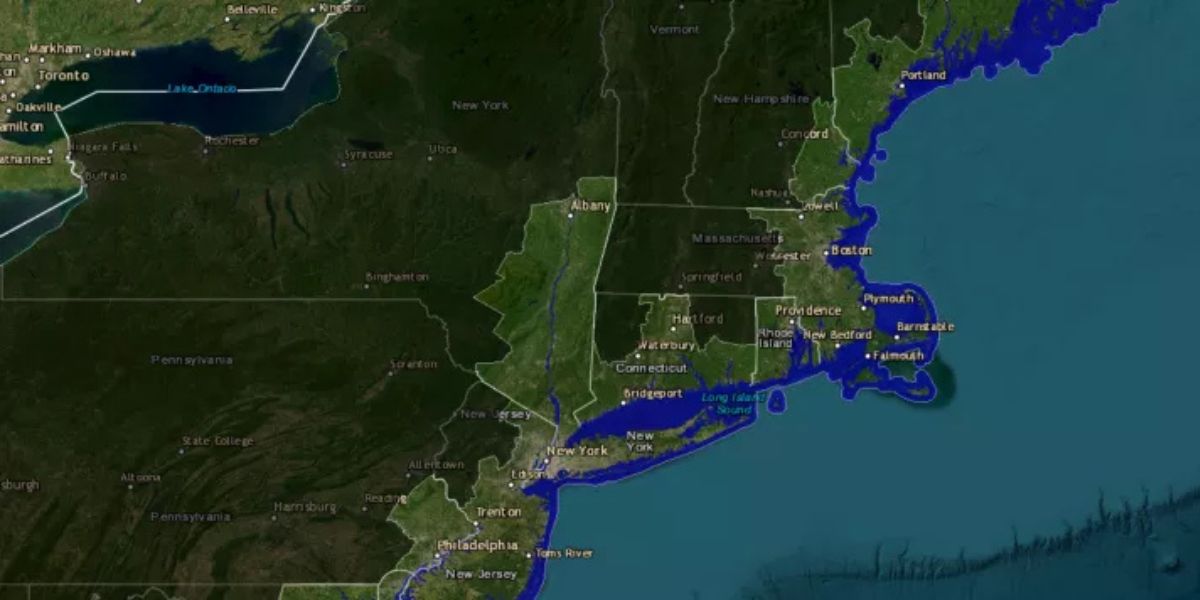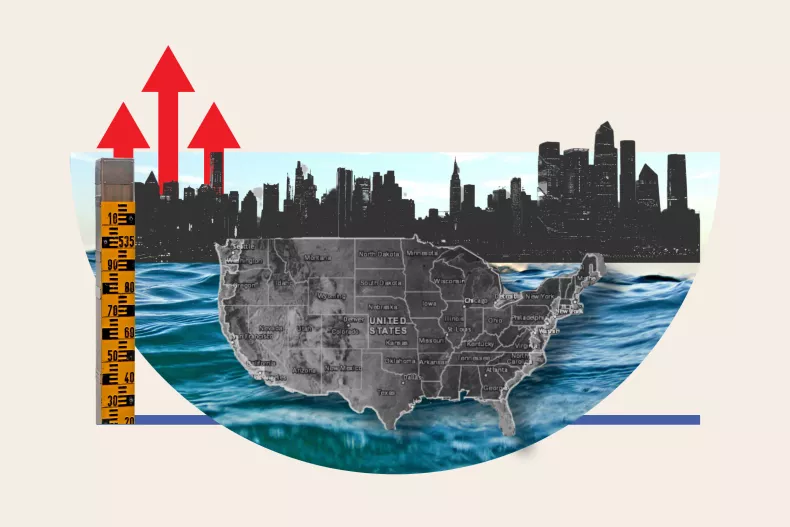Rising sea levels have become a big problem for coastal cities in the U.S. According to the National Oceanic and Atmospheric Administration (NOAA), by 2050, the water along U.S. coastlines could rise by on average of about 10-12 inches and many cities might face major challenges due to the same. Several cities near the Atlantic, Gulf, and Pacific coasts could face flooding in the future if the current trend continues and no major steps are taken to slow or stop the trend.
US Cities facing the threat of being underwater by 2050 depicted in map
NOAA’s Sea Level Rise Viewer shows which cities could be affected the most. On the map, the areas that are marked in dark blue show places where sea levels are expected to rise the most.
Pacific Coast
Rising sea levels could affect several major cities on the Pacific Northwest coast:
Washington
Major cities like Everett, Seattle, and Tacoma could be highly affected and Portland and Oregon might also face risks.
California
At-risk cities include San Francisco, Santa Rosa, Concord, Fairfield, Freemont, Vallejo, San Mateo, Oxnard, Thousand Oaks, Oakland, Oceanside and San Diego in the south.
Gulf Coast
Increasing sea levels might affect Mississippi.
Alabama: The city of Mobile is at risk.
Louisiana: New Orleans is vulnerable.
Texas: Cities like Brownsville, Corpus Christi, Houston and Beaumont could be affected by rising water levels.
Florida: Cities like Tampa, St Petersburg, and Cape Coral are at risk.
Atlantic Coast
Florida’s Atlantic coast: Cities like Miami, Port St Lucie, Jacksonville, West Palm Beach, Pompano Beach, Palm Bay and Palm Coast are at risk.
New England: Cities like Bridgeport, Connecticut, Providence, Rhode Island, and Boston, Massachusetts could be affected.
Southern Atlantic states: Cities like Charleston, South Carolina, Savannah, Georgia, Virginia Beach and Norfolk, Virginia, Wilmington, North Carolina, and Baltimore, Maryland are at risk.
Other affected states: Delaware, Maine, New Jersey, and New York may be impacted.
According to NOAA oceanographer, although it is unlikely that entire cities will be completely underwater soon, even a two-foot rise in sea level or more above the average high tide, it could cause severe disruption and/or damage.
NOAA oceanographer’s warning
A NOAA oceanographer Dr. William Sweet, who is working to track and predict sea level changes and flood risk, told Newsweek that he doesn’t think any U.S. communities will go underwater by 2050, but warned that flooding might happen more often and lead to serious damage if steps are not taken to address it.
He said that simple full moon tides and changes in the wind can lead to flooding. He mentioned that even when the weather is clear and there are no storms, high-tide flooding can still occur, causing water to flood streets, and storm drains and pooling in neighbourhoods.
Potential impacts on East and Gulf Coast communities
Dr William added that by 2050, even with a one-foot rise in sea level, flooding could happen more often, especially in East and Gulf Coast communities. Currently, some communities experience flooding 5 to 10 days a year, but with rising sea levels, flooding will get deeper and more severe.
He was quoted by the leading daily as saying, “With a foot of sea level rise or even a little bit more, in areas where there are high rates of land subsidence, which is the case in Texas, with the withdrawal of fossil fuel and groundwater for consumption, a foot, a foot and a half, perhaps, in areas doesn’t put much underwater.”
Challenges Coastal cities are facing
Coastal cities are facing several challenges, including more frequent flooding on sunny days, mixing of saltwater with freshwater supplies, erosion of beaches and coastal areas, damage to infrastructure and property, and economic impacts on tourism and local businesses.
These issues can affect communities even before they are completely flooded. The cost of flood repairs, falling property values and the exodus of residents and businesses can impact local economies. Also, increased noise pollution in oceans due to climate change adds more challenges for coastal ecosystems and communities.
How to protect coastal cities?
As rising sea levels become a bigger threat, coastal areas need to take proactive measures to protect themselves. Some of the strategies include:
Improvement in infrastructure by strengthening seawalls, upgrading stormwater systems and elevating important buildings.
Zoning changes like updating buildings rules and restricting construction in places that are at high risk of flooding.
Natural solutions like restoring wetlands and mangroves, which can act as natural barriers to absorb flood waters.
Moving people and assets from dangerous areas to safer places.
These actions need a lot of money and planning, but the cost of inaction could be far greater. In some regions, the collapse of Atlantic currents could lead to dangerous cooling, which can make it even more important to take action on climate change immediately.
The NOAA sea level rise map is a powerful tool that helps understand the risks and in decision-making. As we might face more flooding in future, it is important for government, scientist, leaders and people to work together to protect coastal cities for future generations.










